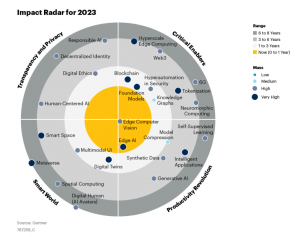From AI to hybrid experiences: SHI’s experts analyze the emerging tech disrupting 2023 and beyond:
Discover how you can adapt to the future state of IT.

The 2023 Gartner® Emerging Technologies and Trends Impact Radar – according to the report itself -“highlights the technologies and trends that have the most potential to disrupt a broad cross-section of markets.” In a way, it can be a reliable guide to the rising developments that tech vendors and product leaders alike must be prepared to adapt to. With the smart world expanding, the productivity revolution accelerating, and new critical technologies emerging, there are new business and monetization opportunities appearing every day. Keeping an eye on advances in AI as well as increased scrutiny of transparency and privacy, the report highlights 26 emergent technologies and trends that vendors must respond to. While most of these innovations are three to eight years from crossing over to majority adoption, it remains crucial to stay informed of the rapid changes in the technology sector.
While it’s hard to stay ahead of the curve, SHI’s resident experts are here to drop their forecasts and takeaways and explain what you can do to start efficiently adapting to the new frontier.
The most impactful trend
SHI’s Field Chief Technology Officer, Lee Ziliak, is especially keyed in on the coming impact of AI because of how many areas of business that it’s now touching, if not pushing.
“It will continue to expand both its areas of impact and its number of products over the next few years at an accelerated rate,” Ziliak says. “As you combine AI with other advancements in things like quantum computing, distributed data, and edge, then the prospects become almost mind-boggling because as AI touches more disciplines, the speed at which advancements take place accelerates as well.”
The most overlooked area of impact to consider
Ziliak sums it up in one word: “Security.”
Don’t worry; he expands on it too: “For all the good that some of these technological advancements bring to the table, there are bad actors looking to benefit from these same advancements. Some of it is touched on, like responsible AI and digital ethics. And while these are good notions to be sure, these same tools are available to actors that will use them irresponsibly and unethically; therefore, we must be cognizant of this and protect against it.”
On the other hand, SHI’s Dave Gruver, Field Chief Technology Officer, feels it’s also worth calling out the risks of having more citizen developers:
“Microsoft and others have been working to create more approachable tools to democratize the software development process. This accelerates greatly with emerging AI toolsets. As more and more employees gain ability to create ever more sophisticated workflows, tools, and application interactions, there is significant risk to the business. The employees are typically not trained in app-dev best practices for security or efficiency. As they create more and more tools, businesses will be at greater risk for exploitation by bad actors, and unanticipated performance issues and likely increased cloud compute costs.”
In turn, Ziliak argues that while most “trained” developers have at least a passing relationship with security practices, over 50% of all apps developed at organizations without DevSecOps practices are vulnerable to attack, and at least one vulnerability is found in 84% of opensource code scans.
“This will just get worse with the trend that Dave [Gruver] points out,” Ziliak adds.
Both experts agree that tool sprawl will be an issue that needs to be managed as well.
“I think about the number of zombie SharePoint sites in existence,” Gruver says. “What if those were active tools mining data and interacting with applications long after the developer left town? Finding the balance between enabling a business unit to self-solve without IT intervention – while also maintaining security and performance – will be a key focus area for successful businesses.”
The actions to avoid
After reviewing the trend report, our experts suggest being strategic about any sudden reactions to the developments it details.
“Some of them may turn out to be only trends,” Ziliak says. “Don’t jump in on something unless it matches your strategic direction. Equally as important, make sure the technology has matured enough to meet your organizational needs without introducing risk. A lot of these companies, for example, are startups, which is a sort of risk in and of itself.”
If that’s true, then what steps should you take?
The path forward
SHI’s experts advise that 2023 is a year like any other: “Organizations should establish their objectives, develop a roadmap to achieve them, and follow their plan to get there. Nothing in the report is a one-and-done event. What this report does is provide you with insight on possible solutions that you can look at while you plan your next objectives.”
For example, if your strategic objective is to increase customer retention and lower the cost, maybe this report convinces you to leverage AI to examine customer interactions, or billing, or any other factor that could change the trend. Ultimately, organizations need to take advantage of the data they have and use new technology to exploit it.
Fortunately, SHI is here to not only advise on your data but provide your new technology too. With our innovation labs teams examining emerging technologies, SHI is partnering with VCs and the companies they invest in to better understand these innovations and how they can be best leveraged.
Any expert would agree that with our real-world expertise that helps customers to make decisions on trends like these every day, SHI is the partner to keep you on the cutting edge with custom solutions and service.
Reach out to solve what’s next with us today.
GARTNER is a registered trademark and service mark of Gartner, Inc. and/or its affiliates in the U.S. and internationally and is used herein with permission. All rights reserved.





